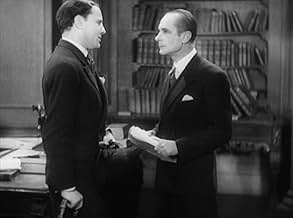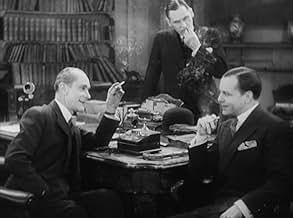Mary
- 1931
- 1h 18min
CALIFICACIÓN DE IMDb
5.7/10
1.1 k
TU CALIFICACIÓN
Agrega una trama en tu idiomaA juror in a murder trial, after voting to convict, has second thoughts and begins to investigate on his own before the execution.A juror in a murder trial, after voting to convict, has second thoughts and begins to investigate on his own before the execution.A juror in a murder trial, after voting to convict, has second thoughts and begins to investigate on his own before the execution.
- Dirección
- Guionistas
- Elenco
John Mylong
- John Stuart
- (as Jack Mylong-Münz)
Opiniones destacadas
A woman is found murdered with another woman, Mary Baring, with whom she'd been heard to be arguing, present, in a daze. It seems like an open-and-shut case and Baring is put on trial for murder. During deliberations, 11 of the 12 members think she's guilty. The sceptical one is Sir John Menier who thinks there are holes in the case. However, he is talked round and Baring is found guilty. After the case Menier still has his doubts and wishes he'd been more forceful in arguing against a guilty verdict. He starts to do his own investigating.
In 1930 Alfred Hitchcock released Murder!, an intriguing murder-thriller. While Murder! Was being shot, Hitchcock was simultaneously making Mary, a German-language version of it, using the same sets but German actors. Mary is almost frame-for-frame and word-for-word (once translated!) the same as Murder! Though manages to run 19 minutes shorter. German must be a more succinct language than English...
The end result is almost as good as Murder! An original start, introducing much of the circumstances around the murder via a murder trial and introducing the main character, Menier, through the jury's deliberations.
The plot developments are good and the climax is quite Shakespearean, which is appropriate considering that the setting is the theatre and most of the characters are theatre actors and crew.
I watched the two films less than day apart and Murder! Was fresh in my mind when I watched Mary. Production values seem a bit lower on Mary and Hitchcock makes less use of clever camera angles in Mary. On the plus side, the irritating smash cuts in Murder! Are not there in Mary. Being longer, Murder! Seems more tension-filled too.
The subtitling on the version of Mary I watched was quite shonky, which also detracted from the film.
Now for the big question: why did Hitchcock make a German version of Murder!? I guess that sound in movies was so new and primitive that simply dubbing Murder! Into German wasn't an option. In the silent era a movie could easily be adapted into another language - just change the dialogue cards!
But why bother at all? My guess is that Germany was a large cinematic market and/or Hitchcock had a large fan base in Germany, hence a film specifically for that market. It's like (30 years later) the Beatles re-recording and releasing many of their early stuff in German.
It's worth noting that this was the one and only time Hitchcock made a foreign-language version of one of his movies. Either Mary wasn't as good an idea as he imagined or technology improved and soon after this his films were dubbed or sub-titled for foreign audiences.
In 1930 Alfred Hitchcock released Murder!, an intriguing murder-thriller. While Murder! Was being shot, Hitchcock was simultaneously making Mary, a German-language version of it, using the same sets but German actors. Mary is almost frame-for-frame and word-for-word (once translated!) the same as Murder! Though manages to run 19 minutes shorter. German must be a more succinct language than English...
The end result is almost as good as Murder! An original start, introducing much of the circumstances around the murder via a murder trial and introducing the main character, Menier, through the jury's deliberations.
The plot developments are good and the climax is quite Shakespearean, which is appropriate considering that the setting is the theatre and most of the characters are theatre actors and crew.
I watched the two films less than day apart and Murder! Was fresh in my mind when I watched Mary. Production values seem a bit lower on Mary and Hitchcock makes less use of clever camera angles in Mary. On the plus side, the irritating smash cuts in Murder! Are not there in Mary. Being longer, Murder! Seems more tension-filled too.
The subtitling on the version of Mary I watched was quite shonky, which also detracted from the film.
Now for the big question: why did Hitchcock make a German version of Murder!? I guess that sound in movies was so new and primitive that simply dubbing Murder! Into German wasn't an option. In the silent era a movie could easily be adapted into another language - just change the dialogue cards!
But why bother at all? My guess is that Germany was a large cinematic market and/or Hitchcock had a large fan base in Germany, hence a film specifically for that market. It's like (30 years later) the Beatles re-recording and releasing many of their early stuff in German.
It's worth noting that this was the one and only time Hitchcock made a foreign-language version of one of his movies. Either Mary wasn't as good an idea as he imagined or technology improved and soon after this his films were dubbed or sub-titled for foreign audiences.
It is late night when the dwellers of a street hear a scream in the apartment of the actress Mary Baring (Olga Tschechowa). A police officer arrives, and the neighbors see Mary dazed and confused, with blood on her clothes and on a poker, and the body of her colleague Ellen Moore on the floor. An empty bottle of brandy is on the table and Mary is in shock with no recollection of what happened. The drunken Mr. Moore says that Mary and Ellen were rivals in the theater and the police take Mary to the precinct. There is a trial, and the jurors believe Mary is guilty, but the famous actor Sir John Menier (Alfred Abel) believes she is not guilty. However, he is not able to change the position of the other jurors and is forced to change his vote to guilty. Mary is sentenced to the gallows, but Sir John decides to conduct his own investigation to prove that Mary is innocent.
"Mary" (1931) is a German spoken remake of "Murder!" (1930) that was shot simultaneously on the same sets of "Murder!" by Alfred Hitchcock with a German-speaking cast. The plot is interesting, about a murder and the woman accused and considered guilty by the jurors. There is one moment, when Sir John Menier exposes his opinion, that seems to be the inspiration to "12 Angry Men" (1957) when only one juror disagrees from the others. The real killer is a weird guy, wearing a dress to perform at the circus. After watching "Mary", I have finally finished to see or see again all the Alfred Hitchcock features and written a review in IMDb for each one. My vote is seven.
Title (Brazil): "Mary"
"Mary" (1931) is a German spoken remake of "Murder!" (1930) that was shot simultaneously on the same sets of "Murder!" by Alfred Hitchcock with a German-speaking cast. The plot is interesting, about a murder and the woman accused and considered guilty by the jurors. There is one moment, when Sir John Menier exposes his opinion, that seems to be the inspiration to "12 Angry Men" (1957) when only one juror disagrees from the others. The real killer is a weird guy, wearing a dress to perform at the circus. After watching "Mary", I have finally finished to see or see again all the Alfred Hitchcock features and written a review in IMDb for each one. My vote is seven.
Title (Brazil): "Mary"
If you only speak German, you should watch this version. If you speak English, you should just watch Alfred Hitchcock's film Murder! (1930) because it's exact same movie, using the exact same sets and plot, just with different actors.
For all practical purposes, a remake, in German, of "Murder!" It is stark and frantic, but the plot is the same. The editing is flawed and so things do not move fluidly. Also, the actors seem more stiff and less interesting. It's as if Hitchcock felt he could give the German people a gift, but move on quickly. I agree that the tension is much less. The final scene is one of the most dramatic of any the master produced, but here it doesn't have quite the same impact. See it only if you wish to have a full view of early Hitchcock films. That was my motivation.
The Hitchcock/Truffaut book,which is actually a very long interview ,something like "the Beatles anthology" in pop music ,gives us many interesting informations about "Mary" ,a movie the master liked.Although he told Truffaut he detested the whodunits ,those riddles a la Agatha Christie,"Mary" featured "things we did for the first time":stream of consciousness,play in the play a la "Hamlet" references to transvestism and even hints at (veiled) homosexuality,which was a "crime" in Great Britain as it was in Germany at the time....
That said,the story drags on a bit and the running time could have been boiled down to one hour,which would have enhanced the really good scenes: IT was Herbert Marshall's first talkie and the scene when he's shaving and thinking for a clue renews the way the detective investigates.The unfinished manuscript is also a very good idea.But the bravura passage remains the final circus.One can also note the scene of the verdict we hear from the empty juror's room.
There are elements which would appear later in Hitchcock's work: the theater ("Stage fright",also a whodunit,btw),of course "Psycho" (a man in drag) and "vertigo" (the finale which makes you feel dizzy).
This is another early Hitchcock which is not only for completists.
That said,the story drags on a bit and the running time could have been boiled down to one hour,which would have enhanced the really good scenes: IT was Herbert Marshall's first talkie and the scene when he's shaving and thinking for a clue renews the way the detective investigates.The unfinished manuscript is also a very good idea.But the bravura passage remains the final circus.One can also note the scene of the verdict we hear from the empty juror's room.
There are elements which would appear later in Hitchcock's work: the theater ("Stage fright",also a whodunit,btw),of course "Psycho" (a man in drag) and "vertigo" (the finale which makes you feel dizzy).
This is another early Hitchcock which is not only for completists.
¿Sabías que…?
- TriviaA copy of the film is included as a bonus feature on the Kino Lorber Studio Classics DVD and German DVD releases of Murder! (1930) and the French DVD release of La posada maldita (1939).
- ErroresAs Sir John interviews Mary in jail, it is established in long-shot that both are sitting at opposite ends of a long table. During frontal closeups, the widths of the planks that make up the tabletop reveal that very randomly either the table is turning between shots or both persons repeatedly switch places.
The exact same continuity error also applies to the American version of the movie, Murder! (1930).
- ConexionesAlternate-language version of Murder! (1930)
Selecciones populares
Inicia sesión para calificar y agrega a la lista de videos para obtener recomendaciones personalizadas
Detalles
- Fecha de lanzamiento
- Países de origen
- Idioma
- También se conoce como
- Secreto de la noche
- Locaciones de filmación
- Productora
- Ver más créditos de la compañía en IMDbPro
- Tiempo de ejecución1 hora 18 minutos
- Color
- Relación de aspecto
- 1.20 : 1
Contribuir a esta página
Sugiere una edición o agrega el contenido que falta































